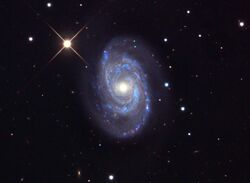Astronomy:NGC 5371
| NGC 5371 | |
|---|---|
 NGC 5371 imaged by a 24 inch telescope | |
| Observation data (J2000 epoch) | |
| Constellation | Canes Venatici |
| Right ascension | 13h 55m 39.9s[1] |
| Declination | +40° 27′ 42.4″[1] |
| Redshift | 0.00850±0.00019[2] |
| Helio radial velocity | 2,552±1 km/s[3] |
| Distance (comoving) | 0 ± 0 Mly (000 ± 00 Mpc)h−10.73 |
| Distance | 129.5 ± 32.4 Mly (39.70 ± 9.92 Mpc)[4] |
| Apparent magnitude (V) | 11.3[5] |
| Characteristics | |
| Type | SAB(rs)bc[5] |
| Mass | 1.86×1011[4] (baryonic) M☉ |
| Apparent size (V) | 4.4′ × 3.5′[5] |
| Other designations | |
| NGC 5371 and 5390, UGC 8846, PGC 49514[6] | |
NGC 5371 is a face-on spiral galaxy in the northern constellation Canes Venatici. It was discovered on January 14, 1788 by German-British astronomer William Herschel. The nearby NGC 5390 appears to be a duplicate entry for NGC 5371, since there is nothing at the former's position.[7] NGC 5371 has an apparent magnitude of 11.3 and an angular size of 4.4′ × 3.5′.[5] It is located at a distance of 129.5 ± 32.4 million light-years (39.70 ± 9.92 Mpc) from the Milky Way,[4] and is receding with a heliocentric radial velocity of 2,552 km/s. The galaxy appears to be weakly interacting with the nearby, equidistant Hickson 68 group of galaxies, and thus may be a member.[3] Collectively, they are sometimes dubbed the Big Lick galaxy group, after the city of Roanoke, Virginia.[8]
The morphological classification of NGC 5371 in the De Vaucouleurs system is SAB(rs)bc,[5] indicating a weakly barred spiral galaxy (SAB) with a transitional inner ring structure (rs), and moderately wound spiral arms (bc). The galactic plane is inclined at an angle of 45°±5° to the plane of the sky, with the major axis oriented along a position angle of 195°±3°.[9] This is classified as a LINER-type galaxy and may be in a post-starburst phase. There is an extended or double source of X-ray emission.[10]
Two supernovae have been observed in NGC 5371. Type II-L supernova SN 1994Y was spotted on August 19, 1994, reaching peak B magnitude of 14.2 on August 30.[11] Type IIb supernova SN 2020bio was discovered January 29, 2020. The progenitor may have undergone extensive mass loss, shedding nearly all of its hydrogen envelope.[12]
References
- ↑ 1.0 1.1 Brown, A. G. A. (2021). "Gaia Early Data Release 3: Summary of the contents and survey properties". Astronomy & Astrophysics 649: A1. doi:10.1051/0004-6361/202039657. Bibcode: 2021A&A...649A...1G. Gaia EDR3 record for this source at VizieR.
- ↑ Abazajian, Kevork N. et al. (2009). "The Seventh Data Release of the Sloan Digital Sky Survey". The Astrophysical Journal Supplement Series 182 (2): 543–558. doi:10.1088/0067-0049/182/2/543. Bibcode: 2009ApJS..182..543A.
- ↑ 3.0 3.1 van Driel, W. et al. (November 2016). "NIBLES: an H I census of stellar mass selected SDSS galaxies. I. The Nançay H I survey". Astronomy & Astrophysics 595: 43. doi:10.1051/0004-6361/201528048. A118. Bibcode: 2016A&A...595A.118V.
- ↑ 4.0 4.1 4.2 Lelli, Federico et al. (January 2016). "The Small Scatter of the Baryonic Tully-Fisher Relation". The Astrophysical Journal Letters 816 (1): id. L14. doi:10.3847/2041-8205/816/1/L14. Bibcode: 2016ApJ...816L..14L.
- ↑ 5.0 5.1 5.2 5.3 5.4 König, Michael; Binnewies, Stefan (2017). The Cambridge Photographic Atlas of Galaxies. Cambridge University Press. p. 113. ISBN 9781108103091. https://books.google.com/books?id=OEszDwAAQBAJ&pg=PA113.
- ↑ "NGC 5371". SIMBAD. Centre de données astronomiques de Strasbourg. http://simbad.u-strasbg.fr/simbad/sim-basic?Ident=NGC+5371.
- ↑ Seligman, Courney. "NGC Objects: NGC 5350 - 5399". Celestial Atlas. https://cseligman.com/text/atlas/ngc53a.htm#5371.
- ↑ Brazell, Owen. "April 2014 - Galaxy of the Month: Hickson 68 in Canes Venatici". Webb Deep SKy Society. https://www.webbdeepsky.com/galaxies/object/Hickson+68.
- ↑ Fridman, A. M. et al. (January 2005). "The orientation parameters and rotation curves of 15 spiral galaxies". Astronomy and Astrophysics 430: 67–81. doi:10.1051/0004-6361:200400087. Bibcode: 2005A&A...430...67F.
- ↑ Komossa, Stefanie et al. (September 1999). "X-ray properties of LINERs". Astronomy and Astrophysics 349: 88–96. Bibcode: 1999A&A...349...88K.
- ↑ Tsvetkov, D. Yu.; Pavlyuk, N. N. (January 1997). "Observations of the supernovae SN 1994Y, 1994ae, and 1995J". Astronomy Letters 23 (1): 26–29. Bibcode: 1997AstL...23...26T.
- ↑ Pellegrino, C. et al. (September 2023). "SN 2020bio: A Double-peaked, H-poor Type IIb Supernova with Evidence of Circumstellar Interaction". The Astrophysical Journal 954 (1): id. 35. doi:10.3847/1538-4357/ace595. Bibcode: 2023ApJ...954...35P.
External links
- NGC 5371 on WikiSky: DSS2, SDSS, GALEX, IRAS, Hydrogen α, X-Ray, Astrophoto, Sky Map, Articles and images
Coordinates: ![]() 13h 55m 39.9s, +40° 27′ 42″
13h 55m 39.9s, +40° 27′ 42″
 |


